Question
a) Assume that the world consists of Norway and Sweden and that these countries do not trade with each other. There are two goods in
a) Assume that the world consists of Norway and Sweden and that these countries do not
trade with each other. There are two goods in this world: timber and mobile phones. Assume that
Sweden needs 1 worker to produce a unit of timber and 2 workers to produce a mobile phone. Norway
needs 6 workers to produce a unit of timber and 3 workers to produce a mobile phone. We assume
for simplicity that both countries have 24 workers each. Use the Ricardian model to answer the
following question.
- Draw the Production Possibility Frontiers for timber and mobile phones in both countries. (1 Marks)
b) The aircraft industry in Europe receives aid from several governments, according to some estimates
equal to 20 percent of the purchase price of each aircraft. For example, an airplane that sells for $50
million may have cost $60 million to produce, with the difference made up by European governments.
At the same time, approximately half the purchase price of a "European" aircraft represents the cost
of components purchased from other countries (including the United States). If these estimates are
correct, what is the effective rate of protection received by European aircraft producers? (2 Marks)
c) If tariffs, quotas, and subsidies each cause net welfare losses, why are they so common, especially
in agriculture, among the industrialized countries such as the United States and the members of the
European Union? (1 Marks)
Step by Step Solution
There are 3 Steps involved in it
Step: 1

Get Instant Access to Expert-Tailored Solutions
See step-by-step solutions with expert insights and AI powered tools for academic success
Step: 2

Step: 3

Ace Your Homework with AI
Get the answers you need in no time with our AI-driven, step-by-step assistance
Get Started


